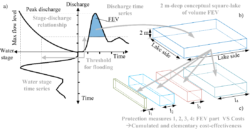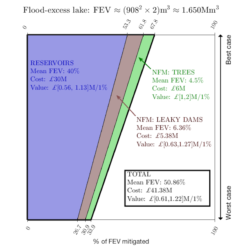LIFD members contribute evidence to UK Parliamentary Flooding Inquiry

Professor Onno Bokhove, Professor Mark Kelmanson and Dr Tom Kent, from the School of Mathematics and Leeds Institute for Fluid Dynamics, University of Leeds, recently provided written evidence to the UK Parliamentary Inquiry into flooding, detailing their work with civil engineers Dr Guillaume Piton and Dr Jean-Marc Tacnet from Université Grenoble Alpes, France.
This interdisciplinary team of researchers have developed a new tool that deliberately eschews equations and scientific jargon, and instead uses a graphical display to create a standardised visualisation (a hypothetical square lake) of the amount of water that needs to be contained within the river to prevent it from causing flooding, see Fig. 1:
The graphic is then overlaid with the various proposed options aimed at holding back and/or capturing floodwaters, along with details of how much each option will cost, see Fig. 2:
The flood-excess lake visualisation was designed with the express intention of empowering decision-makers and flood action groups, as well as the general public, to make quantified judgements on the cost-effectiveness of flood-mitigation plans in order to facilitate enhanced, evidenced-based assessments. It allows quick visual comparison of the benefits provided by the multiple components of a complex scheme (e.g. flood walls, storage, nature-based solutions) and could be easily included in national or regional protocols as part of stakeholder and community communications.
The graphical tool has already been applied to flood prevention in Europe: the French engineers on the team have used it to communicate complex hydrodynamics simulations for the River Brague in Southeast France, in a region that suffered severe flooding in 2015 and 2019. In Slovenia, a non-governmental organisation has used the tool to explore the effectiveness of nature-based solutions, such as the opening of flood plains and the use of dry retention areas, green roofs and urban wet-retention areas.
For a full statement of the evidence provided, see the UK Parliamentary Flooding Inquiry
https://committees.parliament.uk/writtenevidence/9641/pdf/.
Details of the approach appear in the team’s two recent peer-reviewed international publications, both of which have been deliberately written to be accessible to a general-yet-interested audience:
[1] Bokhove, O., Kelmanson, M.A., Kent. T., Piton, G. and Tacnet, J.-M., A cost-effectiveness protocol for flood mitigation plans based on Leeds' Boxing Day 2015 floods, Water 12(3), 652-682, 2020. https://www.mdpi.com/2073-4441/12/3/652
[2] Bokhove, O., Kelmanson, M.A., Kent. T., Piton, G. and Tacnet, J.-M., Communicating (nature-based) flood mitigation schemes using flood-excess volume, River Res. Appl. 35(9), 1402-1414, 2019. https://onlinelibrary.wiley.com/doi/full/10.1002/rra.3507


